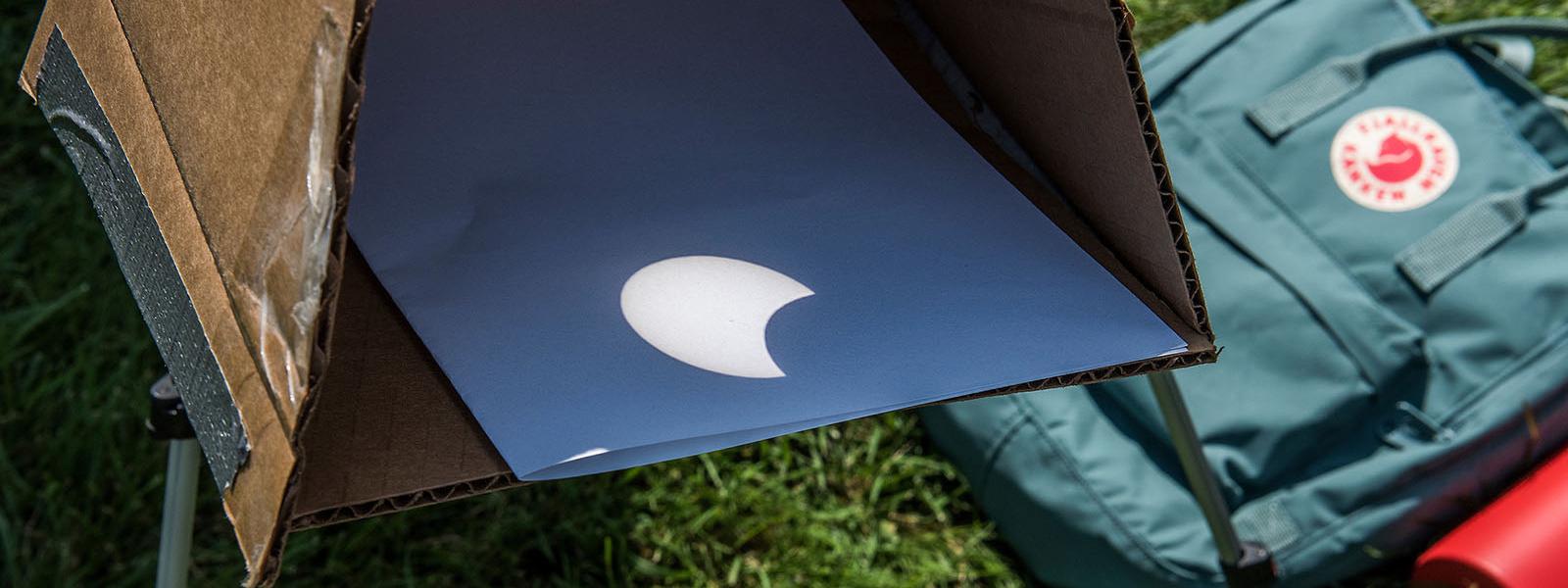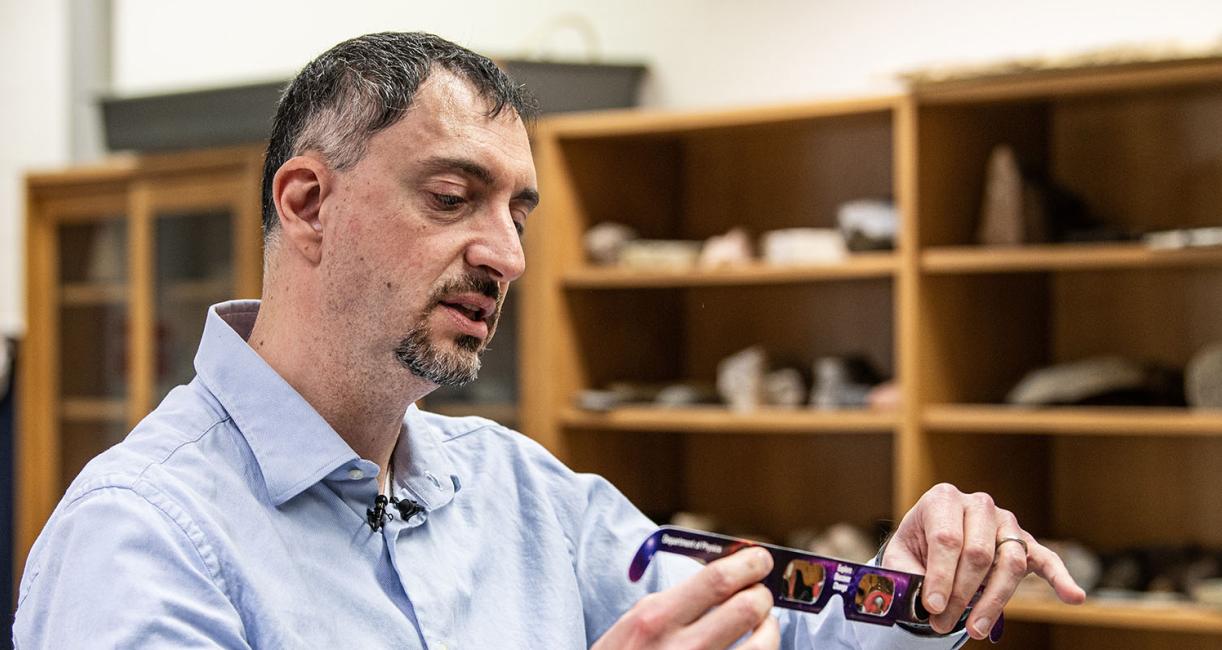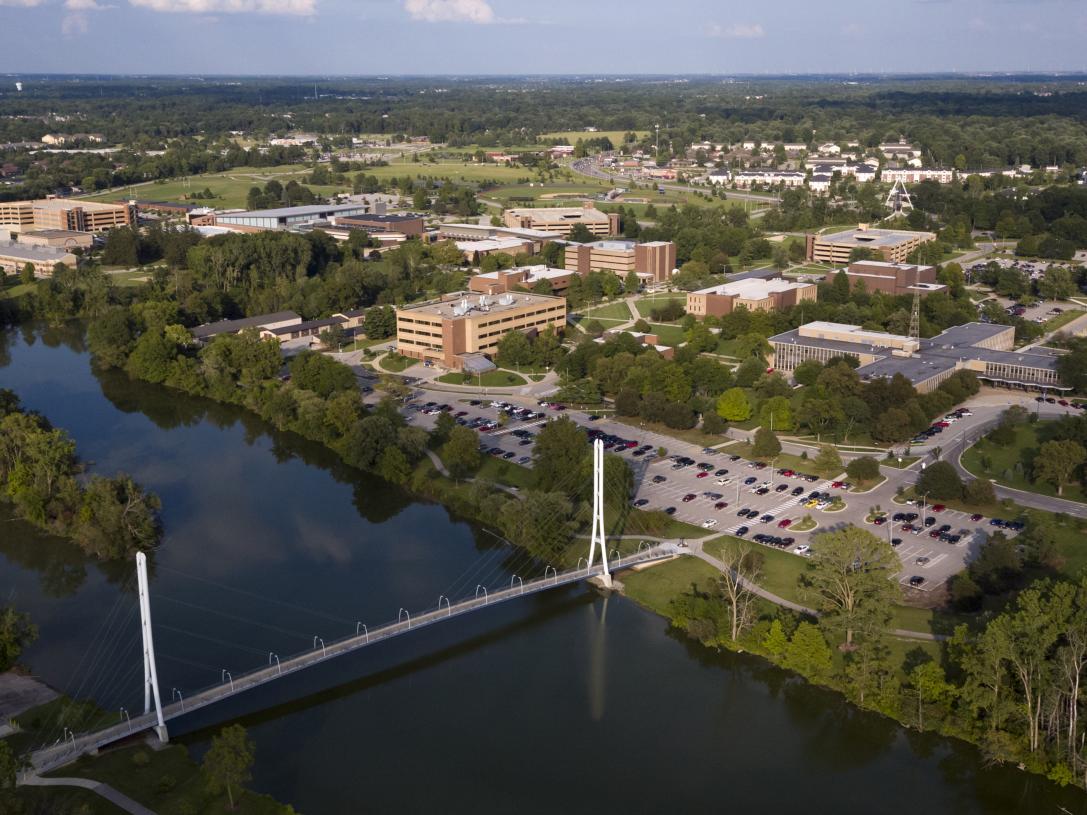



Eugenio Ursino, assistant professor of physics, displays a pair of solar eclipse glasses.

Eugenio Ursino, assistant professor of physics (right), with Finn Finney (left), a sophomore majoring in physics


PFW targets safe gazing, education on eclipse day
By Blake Sebring
March 26, 2024
When the near-total solar eclipse on April 8 peaks at around 3:10 p.m., the instinct may be to take it all in with the naked eye, but Purdue University Fort Wayne plans to offer a safer, more informative option on what will likley be for most a once-in-a-lifetime event.
Cutting to the chase, it’s dangerous to look even indirectly at a solar eclipse without using certified solar glasses. That’s why faculty and students from PFW’s College of Science and its College of Engineering, Technology, and Computer Science will be providing, while supplies last, more than 2,000 free pairs of specialized glasses to anyone who wants to stop by the heart of campus to catch all the action.
The updated eye protection, which is much denser than typical sunglasses, will be distributed on the Science Mall starting at 1:30 p.m. The mall is located just east of the Science Building. Parking lots 4 and 5 will also be reserved from 1 to 4:30 p.m. for use by the general public. Check out the PFW campus map for additional guidance.
Multiple telescopes utilizing proper filters, information tables explaining how to easily build spectrometers and pin-hole cameras, and other activities for all ages will be available. Faculty members will also be there to answer questions.
The goal of event organizers is to give everyone a chance to see and learn safely about the eclipse while explaining how PFW students majoring in physics and astronomy are studying it.
“The main thing for us is that we offer safety glasses, and we offer many different ways to observe,” said Gang Wang, chair of the Department of Physics. “We can teach kids about the spectrums which are not available at home because here you can look at the different components of lights from the sun.”
Eugenio Ursino, an assistant professor of physics, said a few of the devices the children will design on campus can also be utilized later.
“Some of the things we show them will work better on other days to study the composition of sunlight,” Ursino said. “We want to show them the kind of fun we can have.”
As an example, pinhole options utilizing cardboard boxes and shade don’t require looking at the sun and can display a range of colors.
Before the main event, weather permitting, PFW’s ETCS outreach team will be launching a specialized weather balloon at approximately 2:15 p.m. As it rises into the stratosphere, small sensors will collect data to record atmospheric changes such as temperature and altitude. It will also carry a camera.
The balloon utilizes hydrogen to rise above the cloud surface, potentially reaching 80,000 feet. In addition to the technology, it will also carry a payload of concrete, wood, and Legos pieces to test responses to the altitude.
The biodegradable balloon will burst eventually. As soon as it displays a trending direction, two PFW students tracking its flight path will start driving to recover the materials when they land with the aid of a small parachute. Depending on the jet stream, that could be close by or more than three hours away, meaning the students could also be battling substantial interstate traffic resulting from eclipse day mania.
Strong wind gusts on the ground could cancel the release. A recent test on campus required 15 people to control the balloon.
After recovery, if everything plays out as expected, video from the balloon’s 360-degree camera will be posted on the ETCS website in 7-10 days. Pictures will also be posted on the physics department’s Instagram page, instagram.com/pfw_physics, with videos available at pfw.edu/science/physics/rewind-time.
If the weather is overcast, there will still be a period of significant darkness, but the effects will not be as dramatic to watch. There will also be a noticeable temperature drop, Ursino said.
The last partial eclipse viewable from Fort Wayne happened on Aug. 21, 2017, when the moon blocked 86% of the sun. More than 99% of the sun will be blocked on the PFW campus and throughout most of the city this time around, Ursino said.
The last total eclipse in the United States was in 1979, and the next visible from Fort Wayne will be on Sept. 14, 2099.




